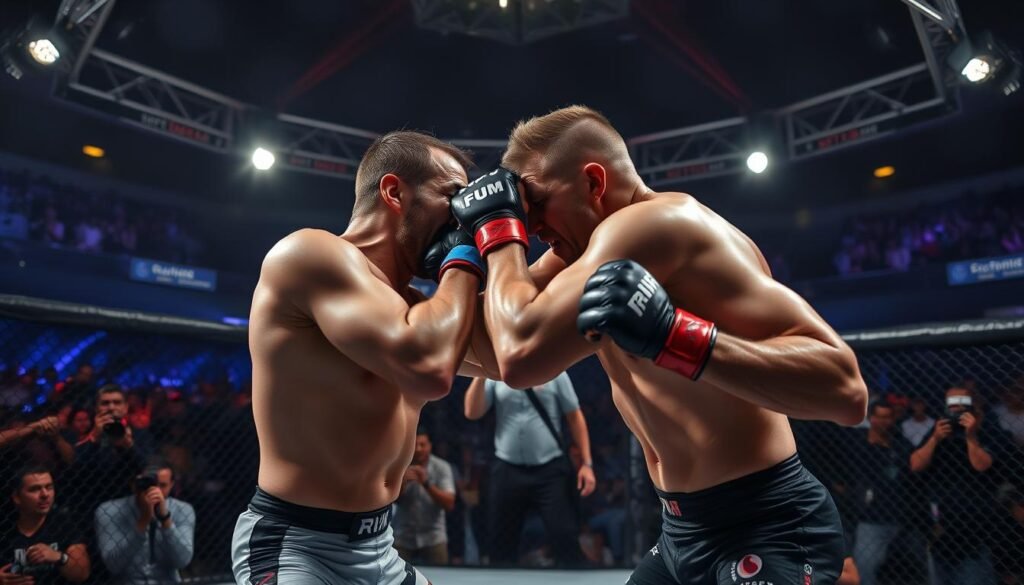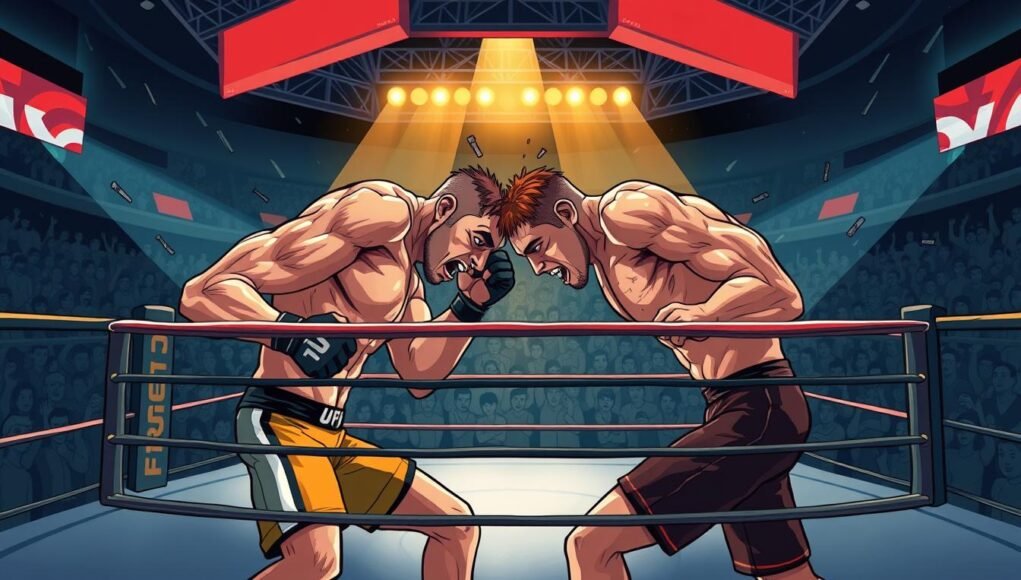In MMA, fans and fighters often wonder if headbutts are legal. “Can you headbutt in UFC MMA?” is a common question. This is because the sport’s rules have evolved over time. In the past, only biting and eye gouging were banned. Today, UFC rules forbid both intentional and accidental headbutts. This change aims to protect fighters and unify the sport’s rules.
Key Takeaways
- Headbutting is not permitted in UFC fights.
- Both intentional and accidental headbutts are grounds for disqualification.
- The evolution of UFC rules focused on fighter safety.
- Early MMA had few regulations compared to modern standards.
- Understanding prohibited moves in UFC is essential for fighters and fans.
- Recent events have highlighted the consequences of illegal strikes in the octagon.
Understanding UFC Regulations on Headbutts
In mixed martial arts (MMA), ufc regulations on headbutts are very important. They keep the sport safe and fair. Since November 2000, when the Unified Rules of MMA were adopted, headbutting became illegal. Referees are strict in enforcing these rules if they are broken.
Referees play a key role in managing headbutting incidents. They decide what the intent was behind a headbutt. Depending on what happened, they might warn, deduct points, or even disqualify a fighter. This authority helps keep things fair and safe for the fighters.
Headbutting affects how matches unfold in interesting ways. It forces fighters to change their tactics. While UFC bans it, other combat sports like Lethwei see it as a key move. This difference sparks many discussions about its use in combat sports.
Athletes need to know the rules well to steer clear of penalties. Being informed boosts their performance. It also makes MMA competitions safer for everyone.
What Are the Prohibited Moves in UFC?
The UFC has strict rules to keep fighters safe and ensure fair play. There are many prohibited moves in UFC that help keep the sport honest. These include headbutting, eye gouging, and hitting the back of the head. Because of the danger it poses, like brain injuries, headbutt rules UFC ban this move.
Other moves that are not allowed are:
- Spiking an opponent on their head or neck
- 12-6 elbow strikes
- Groin strikes
- Throat attacks
- Small joint manipulation
- Foul language
- Rabbit punches
Breaking these rules has tough consequences. Fighters could face:
- Points taken away by the referee
- Being disqualified for bad behavior
- Fines and being suspended
- Not getting their prize money
- Harming their standing in the sport
Not following the rules goes against the UFC’s values of safety and fairness. The Unified Rules of MMA, set in November 2000, help uphold these values. They lay out what conduct is expected in the ring. To learn more about why some moves are banned, read this complete guide on illegal moves in MMA.
Can You Headbutt in UFC MMA?
Is it allowed to headbutt in UFC MMA? This question brings up the sport’s rules. Headbutts are not allowed in UFC to keep the game fair. The rules are clear: no intentional headbutting. If it happens by accident, the ref decides what to do next. This makes the game more complex for fighters in big matches.
The Rules Surrounding Headbutting
UFC lists intentional headbutts as fouls. They want to keep fighters safe and the sport clean. If a ref sees a headbutt on purpose, the fighter could lose points or even be disqualified. This is more likely if the headbutt hurts the other fighter. Knowing the headbutt rules ufc is key for fighters. It changes how they plan their fight.
Consequences of Intentional Headbutts
UFC fighters face big problems if they headbutt, on purpose or not. Losing a point can change who wins. If a headbutt causes an injury, the fighter might be disqualified. This shows how important it is to follow the rules. It keeps everyone safe in the fight.
Headbutting in Mixed Martial Arts: A Historical Perspective
In the early days of MMA, headbutting in mixed martial arts was quite common. Early UFC events had almost no rules, allowing fighters to use headbutts freely. At the first UFC event in 1993, there were just three rules: no biting, no eye gouging, and no groin strikes. This rule set shows how fighters used a wide range of strikes, including headbutts.
The sport began to evolve with the creation of the Unified Rules of MMA in 2000. These rules put a stop to headbutting. The change was made to protect the fighters better and ensure fair fights. This greatly changed how battles were fought in the UFC.
Comparing MMA with other combat sports shows some differences. Take Lethwei, for example, where fighters can still use headbutts. Lethwei champion Dave Leduc says shorter fighters find headbutts very useful. They can use them to hit hard targets like the jaw and cheekbone during clinches.
The table below summarizes the evolution of rules regarding headbutting across various combat sports:
| Combat Sport | Headbutt Rules | Regulatory Changes |
|---|---|---|
| MMA (UFC) | Banned since 2000 | Unified Rules adopted |
| Lethwei | Allowed | No significant changes |
| Boxing | Banned | Standard regulations in place |
As MMA became more popular, it evolved from a niche to a sport loved by over 300 million fans. Adding weight classes and getting more state approval also helped MMA. This made the sport more legitimate and respected.
Even with new rules, fighters still discuss the impact of headbutts in UFC. They look for ways to use close combat to their advantage. Remembering these changes helps us understand modern fight strategies, including UFC fighter headbutt strategy.

Legal Strikes in MMA: What Fighters Can Do
Learning about legal strikes in MMA is key for fighters. They want to do well but follow the rules. The unified rules show which techniques are allowed. This helps fighters plan better strategies. It also keeps competitions safe.
Exploring the Unified Rules of MMA
The Unified Rules of Mixed Martial Arts cover many areas of pro MMA fights. Fights have rounds that last five minutes. Fighters get a minute to rest between these rounds. Non-title fights usually have three rounds, but main events may have five. Title fights always have five rounds.
Fighters need to wear certain gear. This includes approved shorts, gloves, mouthguards, and groin protectors. Sometimes, they can also wear gear to protect their legs and chest. Fights are scored by three judges. They use a ten-point system and look at things like strikes, grappling, and control of the ring. A round scored 10-8 means one fighter was really dominant.
Common Legal Techniques Used in Fights
MMA fighters use a range of allowed strikes to win. Key moves include:
- Punches
- Kicks
- Elbows
- Hammer fists – great against opponents on the ground
- Heel hooks – more in grappling, less in MMA due to risks
- Stomps and soccer kicks – work on untrained opponents but not as much on pros
Knowing these strikes helps fighters train smarter. They keep to the fight rules and stay safe.
Impact of Headbutts in UFC Fights
Headbutts in UFC fights can really change the game, even if they’re not allowed. When they happen by accident, they can hurt fighters a lot. For example, Piera Rodriguez got disqualified in her UFC Vegas 92 match because of two illegal headbutts. These not only changed the fight’s result but also gave her opponent, Ariane Carnelossi, a broken nose and more injuries.
Fighters need to be smart about avoiding headbutts during fights. This means they have to really understand the rules and be quick to dodge them. They use techniques like keeping their hands up to block but still try to stay offensive. Fighters who are shorter might find it easier to use headbutts, which shows that your size can really impact your strategy.
In sports like Lethwei, headbutts are a common move and show how effective they can be. Someone like Bas Rutten thinks these moves are disruptive and even useful outside of sports. But fighters have to think hard before trying a headbutt. If they get caught, they could face penalties, fines, or damage their reputation.
The mental side of headbutts is also important. Fighters know that an accidental headbutt can quickly change a fight’s direction. Because of this, they might switch up their game plans. Understanding all about headbutts is key for anyone in the UFC.
UFC Fighter Headbutt Strategy
In the exciting world of mixed martial arts, understanding the ufc fighter headbutt strategy reveals how competitors work within the rules. Although headbutts are not allowed, fighters still find ways to achieve similar impacts. They do this through smart positioning, quick footwork, and precise strikes.
One famous instance is fighters using ground techniques marked by legends like Mark Coleman. He was known for his headbutts in early MMA. Today, fighters use similar pressure and tactics without breaking the rules. Commentator Joe Rogan has spoken about rethinking the ban on headbutts and soccer kicks, for a more thrilling competition and safety in the cage.
Fighters like Cory Sandhagen push their limits in challenging matches, sparking conversations on sport innovation among fans. Using headbutt-like moves within the rules could offer new ways to attack. The sport keeps evolving, with debates on which moves should stay banned as UFC grows more popular.
| Strategy | Description | Benefits |
|---|---|---|
| Positioning | Creating opportunities by controlling space in the octagon. | Effective attack setups without heavy risk of penalties. |
| Footwork | Utilizing agile movements to maintain balance and evade strikes. | Improved defensive capabilities while positioning for strikes. |
| Transition Strikes | Employing knee kicks and punches that can replicate headbutt intensity. | Maintaining offensive pressure without breaking the rules. |
Ultimately, UFC strategy is evolving. It balances following the rules with finding new, exciting ways to compete and engage fans.
Conclusion
In summary, headbutts in UFC MMA are strictly banned. This rule keeps fighters safe and keeps the sport fair. So, the answer to *can you headbutt in UFC MMA?* is a firm no. It’s not allowed at all.
The rules in MMA are always getting better, making the sport safer. Fighters like Max Holloway show that you don’t need illegal moves to excite. They prove that skill and strategy are key to winning.
As MMA gets more popular, keeping fighters safe is key. Making sure headbutts are not allowed means everyone stays safer. This approach makes the sport better for both athletes and fans.







